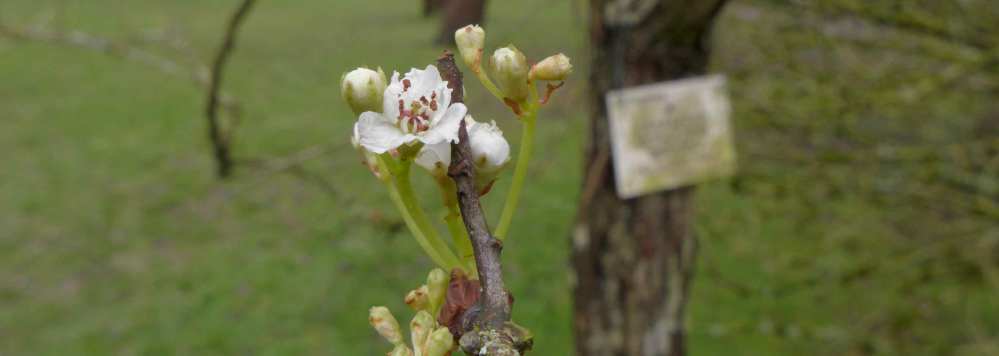Photo: Glastonbury Thorn in Bath Botanical Gardens © Helena Crouch
Leaders: Rob Randall & Helena Crouch
Three members met on a fine cold afternoon for a winter wildlife walk in the park and also to look for plants in flower as our contribution to the BSBI’s New Year Plant Hunt. Near our meeting place, two Bee Orchid (Ophrys apifera) rosettes were spotted on the road verge. As our first mission we paid homage to the Glastonbury Thorn (Crataegus monogyna ‘Biflora’), flowering in the Botanic Gardens, a tree of legend which is remarkable because it flowers at Christmas and again in May. It was a struggle to find wild species in flower, although a small plant of Stone Parsley (Sison amomum) sheltering under a hedge was pronounced to be flowering after examination through a handlens. A splendid Jay provided a distraction, as did some galls. On Bay (Laurus nobilis) Rob showed us big-buds caused by a mite, Cecidophyopsis malpighianus, and a leaf-curl gall caused by a Psyllid bug, Trioza alacris; on Box (Buxus sempervirens) we observed swollen young leaves, caused by a Psyllid bug, Psylla buxi.
Before leaving the park, we looked for rosettes of Meadow Saxifrage (Saxifraga granulata), finding many under a huge spreading chestnut tree. At the edge of the road, we spotted Groundsel (Senecio vulgaris) and Annual Meadow-grass (Poa annua) in flower. A bird-sown Spurge Laurel (Daphne laureola), growing beneath some railings, added another flower to our list.
On the high stone walls of Cow Lane we found flowering Ivy-leaved Toadflax (Cymbalaria muralis) and Trailing Bellflower (Campanula poscharskyana), and at the side of the lane, a patch of Winter Heliotrope (Petasites fragrans) with its scented flowers. Heading out along streets (which were quieter and felt safer than the bustling park), we began to see more plants in flower, mostly opportunistic “weeds” which flower all year round, such as Chickweed (Stellaria media) and Petty Spurge (Euphorbia peplus). We noted another gall, now commonly seen wherever the host plant occurs: a leaf-curl gall on Red Valerian (Centranthus ruber), caused by a bug, Trioza centranthi. The sheltered Georgian basements of Bath provide a frost-free habitat for exotic ferns: we digressed and went to check on known sites for Jungle Brake (Pteris umbrosa), Cretan Brake (Pteris cretica) and Fortune’s Holly-fern (Cyrtomium fortunei), all found to be thriving. We returned to Victoria Park via the Royal Crescent, where we found many patches of the Mediterranean species Tiny Bedstraw (Galium murale), known here since 2010, growing between kerb stones.
It had been a very interesting winter botany walk. Altogether we listed 35 wild or naturalised plant species in flower.
Helena Crouch


Recent Comments